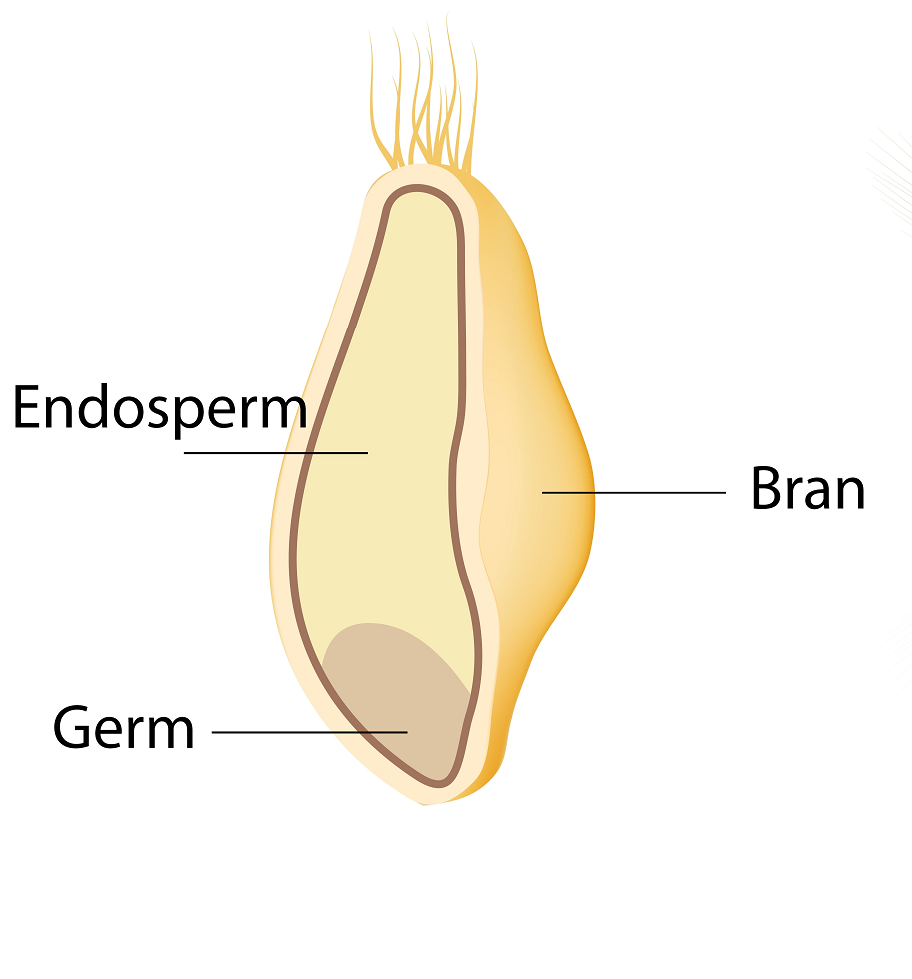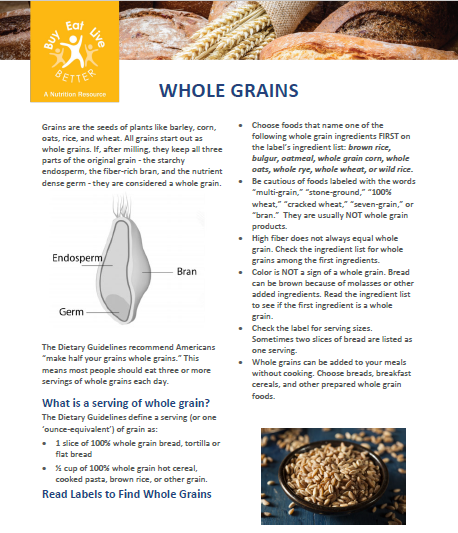Whole Grains

Grains are the seeds of plants like barley, corn, oats, rice, and wheat. All grains start out as whole grains. If after milling, they keep all three parts pf the original grain - the starchy endosperm, the fiber-rich bran, and the nutrient dense germ - they are considered a whole grain. The Dietary Guidelines recommend Americans "make half your grains whole grains." This means most people should eat three or more servings of whole grains each day.

What is a serving of whole grain?
The Dietary Guidelines define a serving (or one 'ounce-equivalent') of grain as:
- 1 slice of 100% whole grain bread, tortilla or flat bread.
- 1/2 cup of 100% whole grain hot cereal, cooked pasta, brown rice, or other grain.
Read Labels to Find Whole Grains
- Choose foods that name one of the following whole grain ingredients FIRST on the label's ingredient list: brown rice, bulgur, oatmeal, whole grain corn, whole oats, whole rye, whole wheat, or wild rice.
- Be cautious of foods labeled with the words "multi-grain," "stone-ground," "100% wheat," "cracked wheat," "seven-grain," or "bran." They are usually NOT whole grain products.
- High fiber does not always equal whole grain. Check the ingredient list for whole grains among the first ingredients.
- Color is NOT a sign of whole grain. Bread can be brown because of molasses or other added ingredients. Read the ingredient list to see if the first ingredient is a whole grain.
- Check the label for serving sizes. Sometimes two slices of bread are listed as one serving.
- Whole grains can be added to your meals without cooking. Choose breads, breakfast cereals, and other prepared whole grain foods.
How to cook grains
|
Grain (1 cup uncooked) |
Add water or broth
|
Bring to a boil, then simmer for:
|
Amount after cooking
|
|---|---|---|---|
|
BARLEY, hulled
|
3 cups |
45-60 minutes
|
3 1/2 cups
|
|
BUCKWHEAT
|
2 cups
|
20 minutes |
4 cups
|
|
BULGUR
|
2 cups
|
10-12 minutes
|
3 cups
|
|
CORNMEAL (polenta)
|
4 cups
|
25-30 minutes
|
2 1/2 cups
|
|
COUSCOUS, whole
|
2 cups
|
10 minutes
|
3 cups
|
|
OATS, steel cut
|
4 cups
|
20 minutes
|
4 cups
|
|
PASTA, whole wheat
|
6 cups
|
8-12 minutes (varies by size)
|
Varies
|
|
RICE, brown
|
2 1/2 cups
|
50-60 minutes
|
3-4 cups
|
|
RICE, brown (instant)
|
1 cup
|
10 minutes
|
1 1/2 cups
|
|
WHEAT BERRIES
|
4 cups
|
Soak overnight, then cook 45-60 minutes
|
3 cups
|
|
WILD RICE
|
3 cups
|
45-55 minutes
|
3 1/2 cups
|
- Substitute an equal part of whole wheat flour for white flour. In other words, if a recipe calls for 2 cups of white flour, use 1 cup of white flour and 1 cup of whole wheat flour.
- Whole wheat is more dense than white flour so when making bread, lower the density by sifting the flour a couple of times. This helps add air into the dough.
- If there is no white flour in your recipe, the end product may be a bit drier than normal. There are two ways to avoid this: adjust your baking time and take the bread or muffins out of the oven sooner or increase your wet ingredients slightly.
- Avoid overmixing when you use a whole wheat flour in baked goods such as cookies or muffins. Too much mixing will make the baked goods tougher or chewier.
- Keeping bread in the refrigerator slows down mold growth but causes bread to go stale faster.
- If bread is not going to be eaten within a week, store it in the freezer.
- Store uncooked grains, rice, and pasta at room temperature in a tightly closed container.
- Store whole grains in a cool,, dry place in a closed package or air-tight container for up to 1 year. For longer storage, refrigerate or freeze.
Featured Recipe
Cold MonkeysSpear banana pieces with toothpick and dip in yogurt.Roll cereal and freeze until hard. |
 |


 You may require
You may require